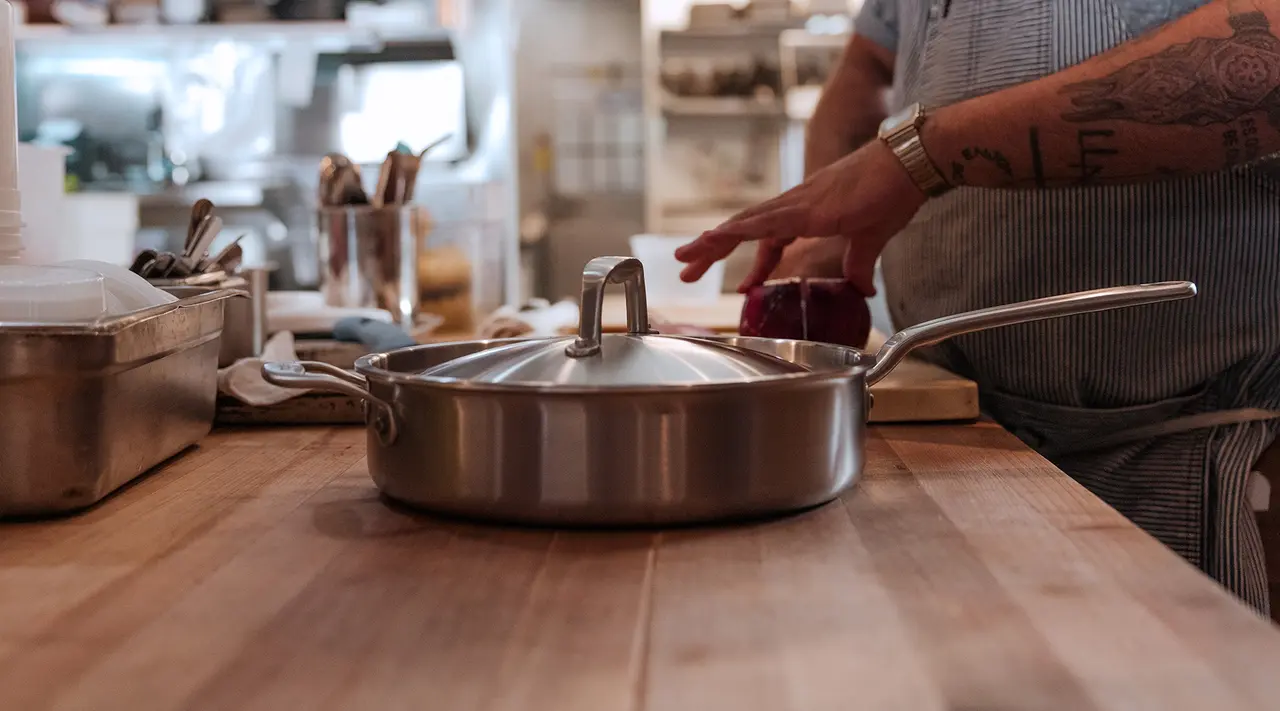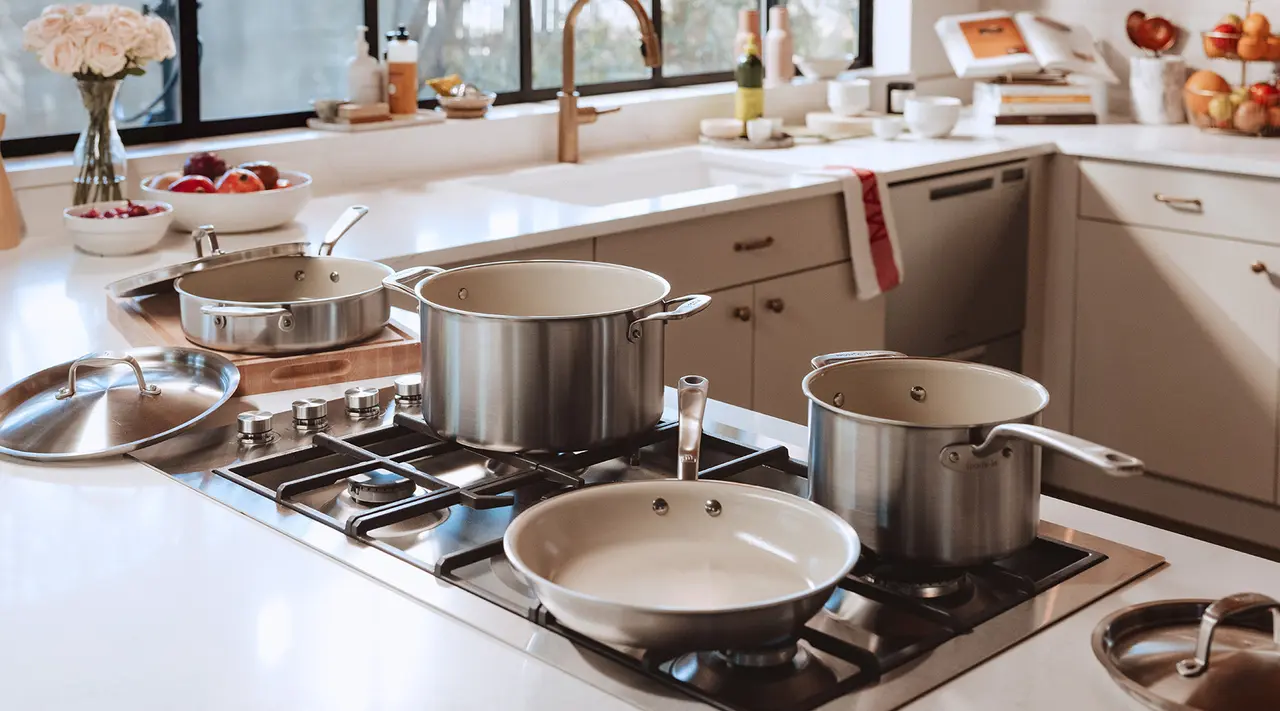These days, the virtually endless supply of options makes shopping for Cookware almost as difficult as shopping for a car. Even when you’ve finally decided that what you really need to round out your collection is a Saute Pan, there are still seemingly infinite choices.
Because we are uniquely obsessed with Cookware of all shapes and sizes, we put together a comprehensive guide that will help you determine what Saute Pan will suit you and your kitchen best. From construction material to how you’ll use it, this checklist will fast track the research portion of your Cookware shopping journey.
But First, What Is a Saute Pan?
A Saute Pan is a pan used for sautéing, a stovetop cooking method requiring a little fat and moderate heat. Commonly sautéed ingredients include alliums, aromatics, mushrooms, vegetables, and meat—anything you’d use for building flavor or want a golden sear on.
Saute Pans are big, with a wide, flat base. Like a Rondeau Pan, they’re shallow with perpendicular walls. But where our Rondeau has a pair of looped u-shaped handles, our Saute Pans have one elongated arm as well as a helper handle.
What Are Saute Pans Used For?
Beyond sautéing, Saute Pans are useful for braising, making soups and stews, and building sauce-based dishes. While Frying Pans work in a pinch for the simplest sautéing, Saute Pans do more. They might even do it better.
- Sautéing: Our Saute Pan’s large surface area allows diced, minced, or chopped ingredients to cook in one single, even layer. This encourages excess moisture and steam to escape, maximizing browning potential.
- Shallow or Pan Frying: Similar to sauteing but ingredients are often left large or whole, and much more fat is used. A Saute Pan is too short for true deep frying, but it’s the perfect size for things like chicken fried steak or pan-fried fish.
- Sweating: Sweating is very similar to sautéing, but happens over low heat so that ingredients soften and cook through but don’t take on color. The term “sweating” is used to describe it because as you cook the ingredients, they lose water, i.e. sweat.
- Finishing Pasta: A Saute Pan’s large surface area is helpful for making flavorful pasta sauces, and its high walls prevent it from evaporating while your pasta cooks. For the sauciest, most luxurious result, add nearly al dente pasta and some pasta water to the Saute Pan and allow it to finish cooking in the sauce.
How to Buy the Best Saute Pan
Saute Pans are less familiar to home cooks, making finding the right one that much harder. The biggest question you need to answer is which construction material you prefer, but there are a few other details you’ll want to keep in mind as well. Below, we cover them all.
1. Choose the Right Material for You
The two most common materials for a Saute Pan are Stainless Clad and Non Stick. Stainless steel is more durable, can take higher temperatures, and is oven-safe to 800F, making it ideal for frying and searing. Non Stick is undefeated when it comes to easy cleanups and chefs love it for delicate proteins like fish. It’s a bit more limited in terms of your temperature range both in the oven (500F) and on the stove (low to medium), but like stainless, it’s non-reactive and easy to use.
2. Make Sure It’s High Quality
As with all Cookware, Saute Pans range in quality. Looking at reviews and customer testimonials can help you confirm whether the Cookware you’re looking at is actually professional-level equipment or if it just comes in fun colors. Both our Stainless and Non Stick Saute Pans feature a Stainless Clad body—the latter just has a few additional layers of professional-quality Non Stick coating.
For additional insight, our articles on Stainless Steel craftsmanship and Non Stick Cookware design cover the features and tech specs you should take note of while researching your options.
3. Look for Oven Safety
One of the great advantages of Saute Pans vs. Frying Pans is that you can braise with them. Stainless is much more common for this because most braises begin with a sear. However, if you’re skipping the sear for softer, juicier meat, then our Non Stick is suitable. Just make sure the temperature doesn’t exceed 500F.
4. Think About How You’ll Use it
Thinking about what and how you cook is critical to selecting the right Saute Pan, because how you hope to use the Saute Pan will guide your choice between Non Stick and Stainless. If fish is a staple in your rotation, then a Non Stick Saute Pan is ideal for moist, flaky filets that won’t stick. If you’re more of a steak and potatoes kind of person, Stainless is better. Consider what you enjoy cooking, or what you’d like to cook more of, and select the pan that will get you there more reliably.
5. Consider Your Collection
To choose one, start with the Cookware in your possession. Consider your preferences, both in terms of form and function. Are there any gaps in your collection that need filling?
If you have several Stainless Clad Frying Pans, it might be helpful to diversify with a Non Stick Saute Pan. But if you vastly prefer the look and feel of Stainless Clad, go with that.
Ready to Shop?
Saute Pans are, in our opinion, canon when it comes to Cookware. Yet while most of us have more than one Frying Pan at our disposal, most home cooks aren’t taking advantage of the Saute Pan’s power and versatility. Fortunately, now that you’ve got our definitive guide to shopping for Saute Pans, you can change that.






























